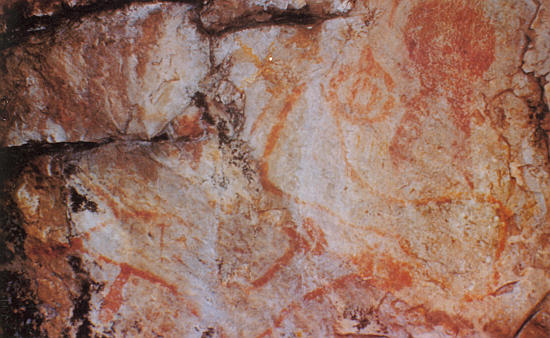As the original inhabitants and caretakers of the land known today as Virginia, the influence of indigenous communities on the land, history, and culture of the commonwealth over the last 12,000 or more years cannot be understated. Yet in the 400+ years since English colonizers came to present-day America, white individuals and white-led institutions obscured the impact and importance of these tribal communities either by omission, destruction, or active erasure.
Brightly colored symbols and figures on the rocks of Paint Lick Mountain in Tazewell County, attributed to Virginia Indians of unknown identity
Photograph originally published in: “Still another album of Tazewell County, Virginia.” Tazewell County Historical Society, 1992. Tazewell County Public Library Photo Collection, hosted by the Library of Virginia.
Today, there are eleven state-recognized Virginia Indian Tribes – Mattaponi, Pamunkey, Chickahominy, Chickahominy Indians Eastern Division, Rappahannock, Upper Mattaponi Indian Tribe, Nansemond Indian Nation, Monacan Indian Nation, Cheroenhaka (Nottoway), Nottoway, and Patawomeck. Many other indigenous groups from within and without the commonwealth, such as the Sappony, Wicocomico Indian Nation, Wolf Creek Cherokee Tribe and many others have shaped Virginia’s past and continue to impact its future. Today’s active, vibrant Virginia Indian communities work diligently to preserve and share their histories and languages, and continue to contribute to Virginia and the nation.
We recognize that the records collected by the Library of Virginia over the centuries from various Virginia-based governments, organizations, and individuals, most predominantly white and male, are necessarily limited and potentially misrepresentative of actual people and events. It is therefore important to note that these records tell history from only one perspective — the perspective generally of whiteness and power. Further, we know that in the past some government officials actively sought to erase indigenous people as a distinct group in the name of so-called “racial purity.” So as the state agency which serves as the main repository for government records, we recognize our complacency in the harm done to the Virginia Indian tribes through erasure by our collecting policies and poor description practices, undertaken primarily by non-indigenous staff members.
In recognition of November as National Native American Heritage Month and with the aforementioned limitations in mind, we share this collection guide to Resources on Virginia Indians at the Library of Virginia. We hope that these materials will not only bring to light records, books, and maps that, while created by the European colonizers documenting Virginia’s tribes, may still have use when put in proper context, but also that the material will encourage additional research. An exploration into the histories, traditions, artwork, and other contributions from Virginia’s tribal communities will help us all to develop a better understanding of Virginia Indians’ role in the commonwealth’s past, present, and future.
-Vince Brooks, Senior Local Records Archivist and Mary Ann Mason, Local Records Archivist










